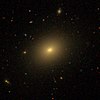|
Per galassia di campo si intende una galassia gravitazionalmente isolata che non appartiene ad un gruppo né ad un ammasso di galassie[1]. La maggior parte delle galassie a bassa luminosità superficiale sono galassie di campo.
Lista delle galassie di campo
Questa è una lista parziale di galassie di campo del vicino universo[1].
| Galassia
|
Tipo
|
Dimensioni (Migliaia a.l.)
|
Costellazione
|
RA
|
DEC
|
Distanza (Milioni a.l.)
|
Note
|
Immagine
|
| Andromeda IV
|
dIrr
|
6
|
Andromeda
|
00h 42m 32.3s
|
+40° 34′ 19″
|
22
|
[2]
|

|
| IC 5152
|
IA(s)m
|
8,3
|
Indiano
|
22h 02m 41.5s
|
-51° 17′ 47″
|
5,8
|
[3]
|

|
| MCG+07-33-027
|
Sa
|
104
|
Ercole
|
16h 02m 16.6s
|
+42° 55′ 01″
|
338
|
[4]
|

|
| NGC 16
|
SAB0-
|
75
|
Pegaso
|
00h 09m 04.3s
|
+27° 43′ 45″
|
123
|
[5][6]
|

|
| NGC 404
|
SA(s)0
|
|
Andromeda
|
01h 09m 27.0s
|
+35° 43′ 04″
|
11,2
|
detta "Il fantasma di Mirach"[1][7]
|

|
| NGC 1182
|
Sa
|
40
|
Eridano
|
03h 03m 28.4s
|
-09° 40′ 13″
|
140
|
|

|
| NGC 1208
|
S0/a
|
110
|
Eridano
|
03h 06m 11.9s
|
-09° 32′ 29″
|
185
|
[8]
|

|
| NGC 1313
|
SB(s)d
|
|
Reticolo
|
03h 18m 15.4s
|
-66° 29′ 50″
|
12,89
|
detta "Galassia Sotto-Sopra"[1][9]
|

|
| NGC 2188
|
Sm
|
|
Colomba
|
06h 10m 09.7s
|
-34° 06′ 50″
|
27,5
|
[1]
|

|
| NGC 2503
|
SAB(rs)bc
|
|
Cancro
|
08h 00m 36.7s
|
+22° 24′ 00″
|
254
|
|

|
| NGC 2683
|
Sc
|
|
Lince
|
08h 52m 41.3s
|
+33° 25′ 18″
|
32,9
|
detta "Galassia UFO"[1]
|

|
| NGC 2903
|
SBbc
|
|
Leone
|
09h 32m 10.1s
|
+21° 30′ 03″
|
30,6
|
[1]
|

|
| NGC 3115
|
S0
|
|
Sestante
|
10h 05m 14.0s
|
-7° 43′ 07″
|
31,6
|
detta "Galassia Fuso"[1]
|

|
| NGC 3621
|
SA(s)d
|
|
Idra
|
11h 18m 16.5s
|
–32° 48′ 51″
|
21,7
|
[1]
|

|
| NGC 4136
|
SABc
|
|
Chioma di Berenice
|
12h 09m 17.7s
|
+29° 55′ 39″
|
40,9
|
[1]
|

|
| NGC 4555
|
E
|
125
|
Chioma di Berenice
|
12h 35m 41.2s
|
+26° 31′ 23″
|
310
|
|

|
| NGC 4605
|
SB(s)c
|
|
Orsa Maggiore
|
12h 39m 59.4s
|
+61° 36′ 33″
|
15,3
|
[1]
|

|
| NGC 5068
|
SAB(rs)cd
|
|
Vergine
|
13h 18m 54.8s
|
-21° 02′ 21″
|
19,8
|
[1][10]
|

|
| NGC 6503
|
SA(s)cd
LINER
|
30
|
Dragone
|
17h 49m 26.514s
|
+70° 08′ 39.63″
|
18,5
|
detta "Lost-In-Space galaxy"[1][11][12][13]
|

|
| UGC 9240
|
IAm
|
15
|
Boote
|
14h 24m 43.4s
|
+44° 31′ 32″
|
9,7
|
|

|
Note
- ^ a b c d e f g h i j k l m Jürgen Materne, The structure of nearby groups of galaxies – Quantitative membership probabilities, in Astronomy & Astrophysics, vol. 74, n. 2, April 1979, pp. 235-243, Bibcode:1979A&A....74..235M.
- ^ Annette M. N. Ferguson, J. S. Gallagher e Rosemary F. G. Wyse, On the Nature of Andromeda IV, in The Astronomical Journal, vol. 120, n. 2, 2000-08, pp. 821-832, DOI:10.1086/301485. URL consultato il 27 maggio 2020.
- ^ Albert A. Zijlstra e Dante Minniti, A Dwarf Irregular Galaxy at the Edge of the Local Group: Stellar Populations and Distance of IC 5152, in The Astronomical Journal, vol. 117, n. 4, 1999-04, pp. 1743-1757, DOI:10.1086/300802. URL consultato il 27 maggio 2020.
- ^ M. Argudo-Fernández, S. Verley e G. Bergond, Catalogues of isolated galaxies, isolated pairs, and isolated triplets in the local Universe, in Astronomy & Astrophysics, vol. 578, 2015-06, pp. A110, DOI:10.1051/0004-6361/201526016. URL consultato il 27 maggio 2020.
- ^ (EN) G. Denicoló, Roberto Terlevich e Elena Terlevich, Group, field and isolated early-type galaxies – I. Observations and nuclear data, in Monthly Notices of the Royal Astronomical Society, vol. 356, n. 4, 1º febbraio 2005, pp. 1440-1465, DOI:10.1111/j.1365-2966.2005.08583.x. URL consultato il 27 maggio 2020.
- ^ (EN) G. Denicoló, Roberto Terlevich e Elena Terlevich, Group, field and isolated early-type galaxies – II. Global trends from nuclear data, in Monthly Notices of the Royal Astronomical Society, vol. 358, n. 3, 11 aprile 2005, pp. 813-832, DOI:10.1111/j.1365-2966.2005.08748.x. URL consultato il 27 maggio 2020.
- ^ (EN) Igor D. Karachentsev, Valentina E. Karachentseva e Walter K. Huchtmeier, A Catalog of Neighboring Galaxies, in The Astronomical Journal, vol. 127, n. 4, 2004-04, pp. 2031-2068, DOI:10.1086/382905. URL consultato il 27 maggio 2020.
- ^ R. P. Kirshner, A., Jr. Oemler e P. L. Schechter, A study of field galaxies. I - Redshifts and photometry of a complete sample of galaxies, in The Astronomical Journal, vol. 83, 1978-12, p. 1549, DOI:10.1086/112363. URL consultato il 27 maggio 2020.
- ^ (EN) The topsy-turvy galaxy NGC 1313*, su eso.org. URL consultato il 27 maggio 2020.
- ^ (EN) J. Materne, The structure of nearby groups of galaxies: quantitative membership probabilities., in A&A, vol. 74, n. 2, 1979-04, pp. 235-243. URL consultato il 27 maggio 2020.
- ^ Lonely galaxy lost in space, Space Daily, 11 giugno 2015.
- ^ NGC 6503, su ned.ipac.caltech.edu, NASA/IPAC Extragalactic Database.
- ^ NGC 6503, in SIMBAD, Centre de données astronomiques de Strasbourg. URL consultato il 26 febbraio 2018.
Collegamenti esterni
|



















